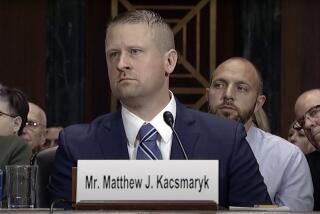In Minnesota, Tobacco Industry Is Gambling On a New Strategy
- Share via
In a strategy they may use across the country, tobacco industry lawyers have launched an aggressive counterattack in Minnesota, accusing state officials of promoting gambling, an activity that can lead to a variety of economic and social problems--including “addiction.”
Cigarette lawyers also suggest that Minnesota has been hypocritical in accusing their industry of targeting minors while permitting gaming interests to do exactly that.
The industry has asked state officials to provide a massive amount of documents about gambling and the problems it has caused in Minnesota, which allegedly include the creation of a new class of addicts, an increase in bankruptcies and the spread of crime. About $4.1 billion is wagered legally in Minnesota each year on the lottery, horse racing, bingo and river casinos.
Among other things, industry lawyers have asked for documents about: whether or to what extent gambling is “an addiction” and imposes costs on society; Minnesota’s marketing and public relations strategies for and its expenditures for advertising of the state lottery; the effects of lottery advertising on minors; the state’s efforts to discourage gambling by minors; state revenue from gambling and state expenditures to help “problem gamblers.”
“The strikingly close parallels between the state’s criticisms of defendants’ sales of cigarettes and its own conduct in advertising and profiting from gambling may make discovery into that area perfectly appropriate to develop impeachment and rebuttal evidence to support defendants’ defenses,” Philip Morris attorney Peter W. Sipkins said in a recent brief.
The brief was filed on behalf of all defendants in the case where Minnesota and Blue Cross/Blue Shield of Minnesota have sued the industry seeking to recover hundreds of millions of dollars in expenses incurred treating smokers.
Virtually all of the 17 states and several localities that have filed similar suits against the industry have some form of legalized gambling. Depending on how the industry fares with its attack in Minnesota, it may use this approach in other states as well.
On Tuesday, Minnesota leveled a sharp response in court and out. “The tobacco industry’s gambling questions are a silly sideshow designed to divert attention from the real questions of this case,” Minnesota Atty. Gen. Hubert H. Humphrey III said.
“Comparing a compulsive disorder with a drug-induced physical disorder is comparing apples and oranges. Moreover, no evidence exists showing that gambling operators broke state laws, but much exists proving tobacco industry lawbreaking.” He also stressed that “gambling doesn’t kill 400,000 people a year” as cigarette smoking does.
The state also filed a brief asserting that the material cigarette lawyers are seeking does not “remotely relate” to the case.
“It is preposterous to argue that cigarettes and gambling are substantially similar,” Minnesota’s special counsel Roberta B. Walburn wrote, referring to the legal standard the defendants would have to meet to be entitled to the documents. “Indeed, no product or activity is analogous to cigarettes and cigarette smoking . . . the single most preventable cause of death in our society.”
To buttress her argument, Walburn’s brief stresses that the defendants have long been aware “that nicotine--the primary pharmacologically active component of cigarettes--is a drug.” Attached to her brief are internal documents from three large cigarette companies, all acknowledging in various terms that they that are marketing a drug or an addictive product.
For example, in a 1969 memo made public for the first time, William L. Dunn Jr., a high-ranking behavioral scientist at Philip Morris, wrote to a colleague: “I would be more cautious in using the pharmic-medical model--do we really want to tout cigarette smoke as a drug? It is, of course, but there are dangerous FDA [Food & Drug Administration] implications to having such conceptualizations go beyond these walls.”
Philip Morris attorney Mike York said the Dunn document was irrelevant. “The word ‘addiction’ does not even appear in this memo,” York said. “More importantly, Skip Humphrey knows that this memo has nothing to do with and has no implications for the FDA’s proposed regulation because from time immemorial everyone has recognized that nicotine is a natural part of tobacco and is in the smoke.”
Minnesota also filed an April 1972 memo by R.J. Reynolds scientist Claude E. Teague Jr. that states “the tobacco industry may be thought of as being a specialized, highly ritualized and stylized segment of the pharmaceutical industry. Tobacco products, uniquely, contain and deliver nicotine, a potent drug with a variety of physiological effects.”
Teague added, “Happily for the tobacco industry, nicotine is both habituating and unique in its variety of physiological actions, hence no other active material or combination of materials provides equivalent ‘satisfaction.”’
RJR spokeswoman Peggy Carter blasted Minnesota lawyers for quoting “snippets from decades-old documents in a now-familiar tactic to mislead potential jurors.” She also accused Minnesota of operating “under a double standard by selectively approving of one controversial lifestyle choice--gambling--over another--smoking--when it regulates and profits from both.”
More to Read
Sign up for Essential California
The most important California stories and recommendations in your inbox every morning.
You may occasionally receive promotional content from the Los Angeles Times.










